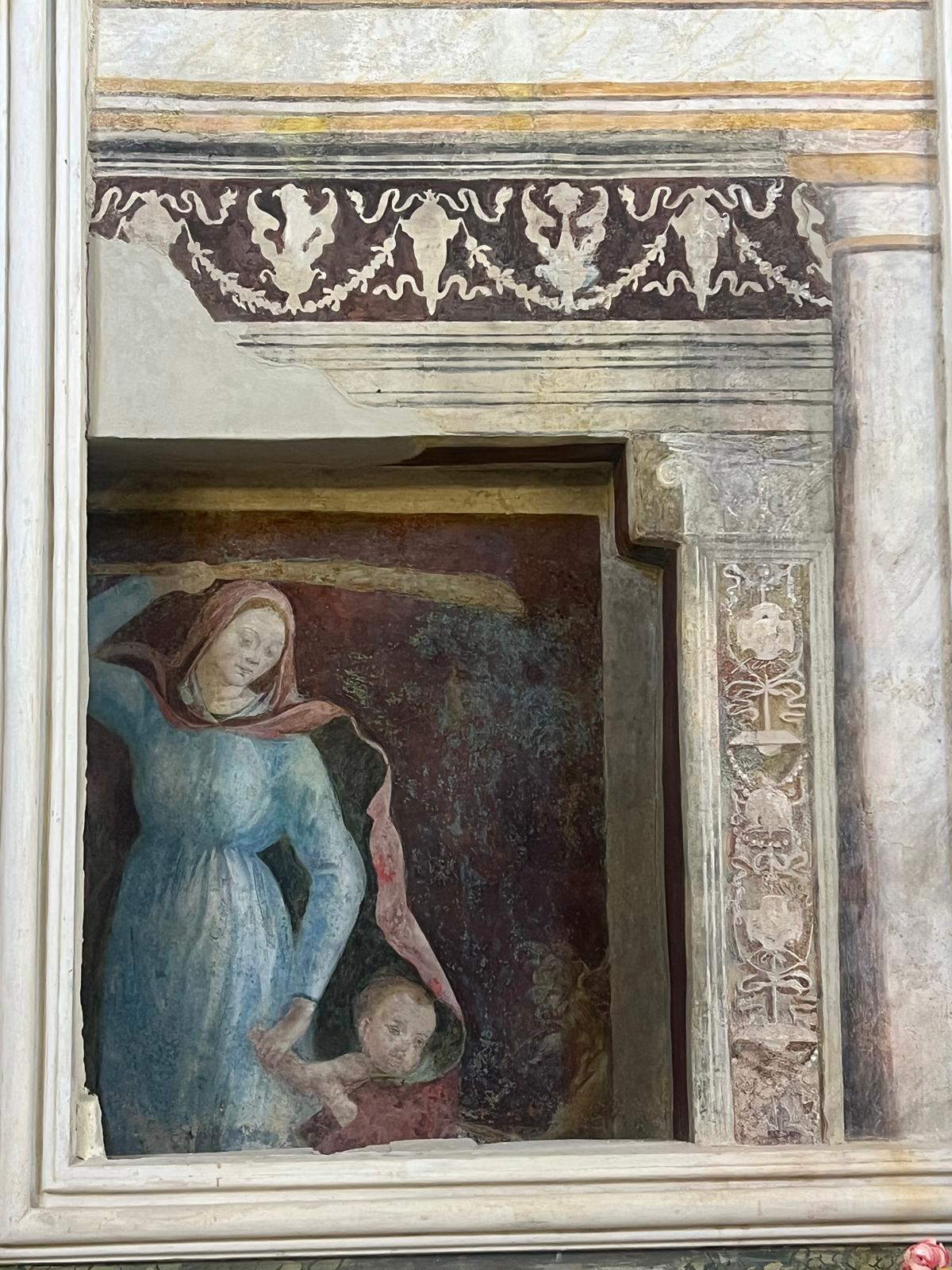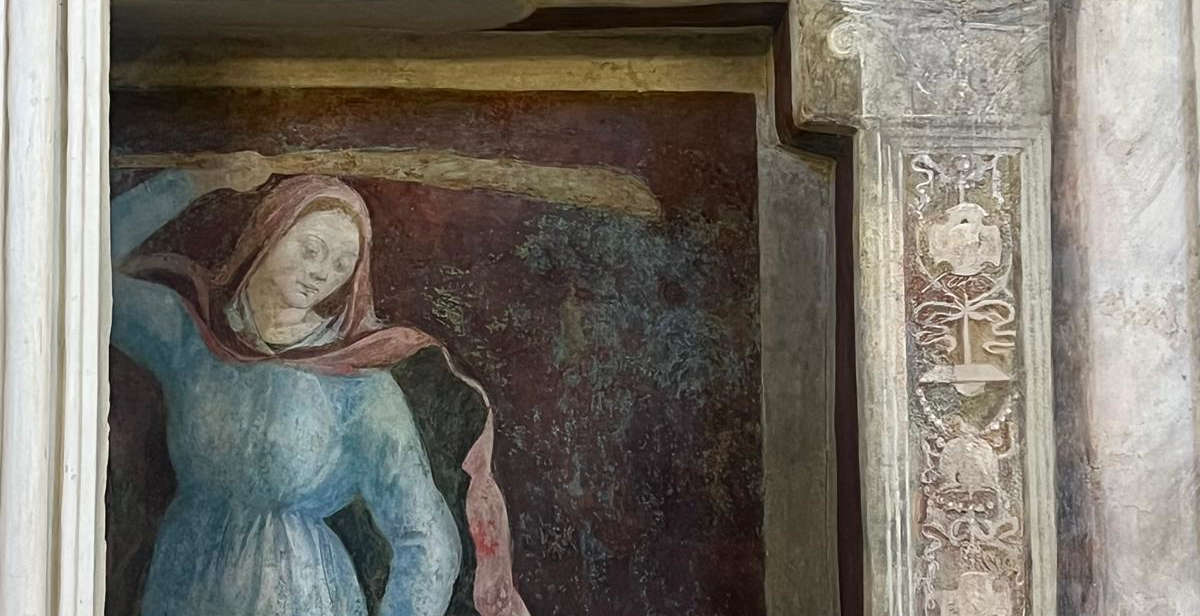An important fragment of Lucca and Tuscan art history resurfaces from the walls of the church of San Martino in Migliano, a hamlet in the municipality of Camaiore, Valfreddana, a few kilometers from Lucca. It is here that, following restoration, a fresco depicting the Madonna del Soccorso, attributed to the Master of the Lathrop Tondo, identified by modern historiography as Michelangelo di Pietro Membrini (1461 - 1525), has been unearthed. The work, hidden for centuries by the superimposition of a stucco altar and a painting on canvas, was virtually unknown to scholars and was known only to a few people in the local community. Its official presentation to the public is set for Sunday, August 31, at 4 p.m., when a ceremony will be held in the Migliano church in the presence of authorities, scholars and supporters of the restoration.
The attribution would be supported by the biographical link between the artist and the village of Migliano: in fact, archival research has documented that the painter spent the last years of his life in this very locality, as a guest of his brother the priest who ruled the parish of San Martino. It was here, in all likelihood, that the artist died, leaving a concrete imprint in the memory of the place and a work that now resurfaces as evidence of his last creative phase.
The fresco, freed from the repainting that obscured its original features, shows the Madonna del Soccorso depicted inside an architraved niche with an elegant grotesque frame. The Virgin raises a staff to drive away the demon threatening a child, ready to take refuge under her mantle. This iconography, known but infrequent, takes on special significance in Migliano. Indeed, the work was located in the back of a chapel designated for wakes and funeral services, near the burial area. In this context, the image of Our Lady of Succor acquired an allegorical value related to the theme of death: the Virgin, with a providential gesture, protected and welcomed the soul of the deceased, symbolized by the child, defending it from the wiles of the devil. A reading that enriches knowledge of Renaissance spirituality and the ways in which art dialogued with the daily life of communities.

The restoration, overseen by Sandro Baroni with the collaboration of Deborah Bindani, under the direction of the Soprintendenza Archeologia, Belle Arti e Paesaggio for the provinces of Lucca and Massa Carrara, was supervised by Valentino Anselmi, an official art historian, and saw the active participation of the local community. Not surprisingly, it was the sensitivity of some parishioners, together with the commitment of parish priest Alessandro Gianni, that prompted the recovery. Concrete support came from the Lucca-Le Mura Lions Club and the Fondazione Cassa di Risparmio di Lucca, which have always been committed to the protection and enhancement of the area’s cultural heritage.
The rediscovery of the fresco is part of the enhancement of an artistic figure still little known to the general public but fundamental to understanding the events of Lucca’s Renaissance. The name Maestro del tondo Lathrop was coined by U.S. art historian Bernard Berenson in 1906 to designate the then-unknown author of a group of high-quality works preserved in various locations between Italy, Spain and the United States. Works that long remained anonymous, united by a refined style and a particular decorative sensibility. It was only in the 1980s that studies made it possible to identify that author with Michelangelo di Pietro Membrini, born and active in Tuscany, who was among the protagonists of Lucca art at the turn of the 15th and 16th centuries.
Membrini, included in the circle of Matteo Civitali and in constant dialogue with the Florentine artists of his time, represents one of the most prominent personalities of northwestern Tuscany. His production testifies to a language that blends local tradition with the assimilation of novelties from Florence and Rome. Not by chance, it is known that the artist stayed in Rome after 1480: a detail confirmed by the grotesques that frame the Migliano fresco, refined decorations that refer directly to the motifs admired by Renaissance artists in the underground rooms of the Domus Aurea, just rediscovered in those years.
The fresco by the Master of the Lathrop Tondo, or Michelangelo di Pietro Membrini, thus fits into a broader path of recovery and enhancement of the widespread artistic heritage of the Lucchesia. The rediscovery of this late work thus brings attention back to a territory, that of the surroundings of Lucca, which in the Renaissance was a center of extraordinary cultural vitality, capable of dialoguing with the great cities of art and at the same time producing original and refined expressions.
 |
| In Lucchesia, a restoration resurfaces a forgotten Renaissance fresco |
Warning: the translation into English of the original Italian article was created using automatic tools. We undertake to review all articles, but we do not guarantee the total absence of inaccuracies in the translation due to the program. You can find the original by clicking on the ITA button. If you find any mistake,please contact us.